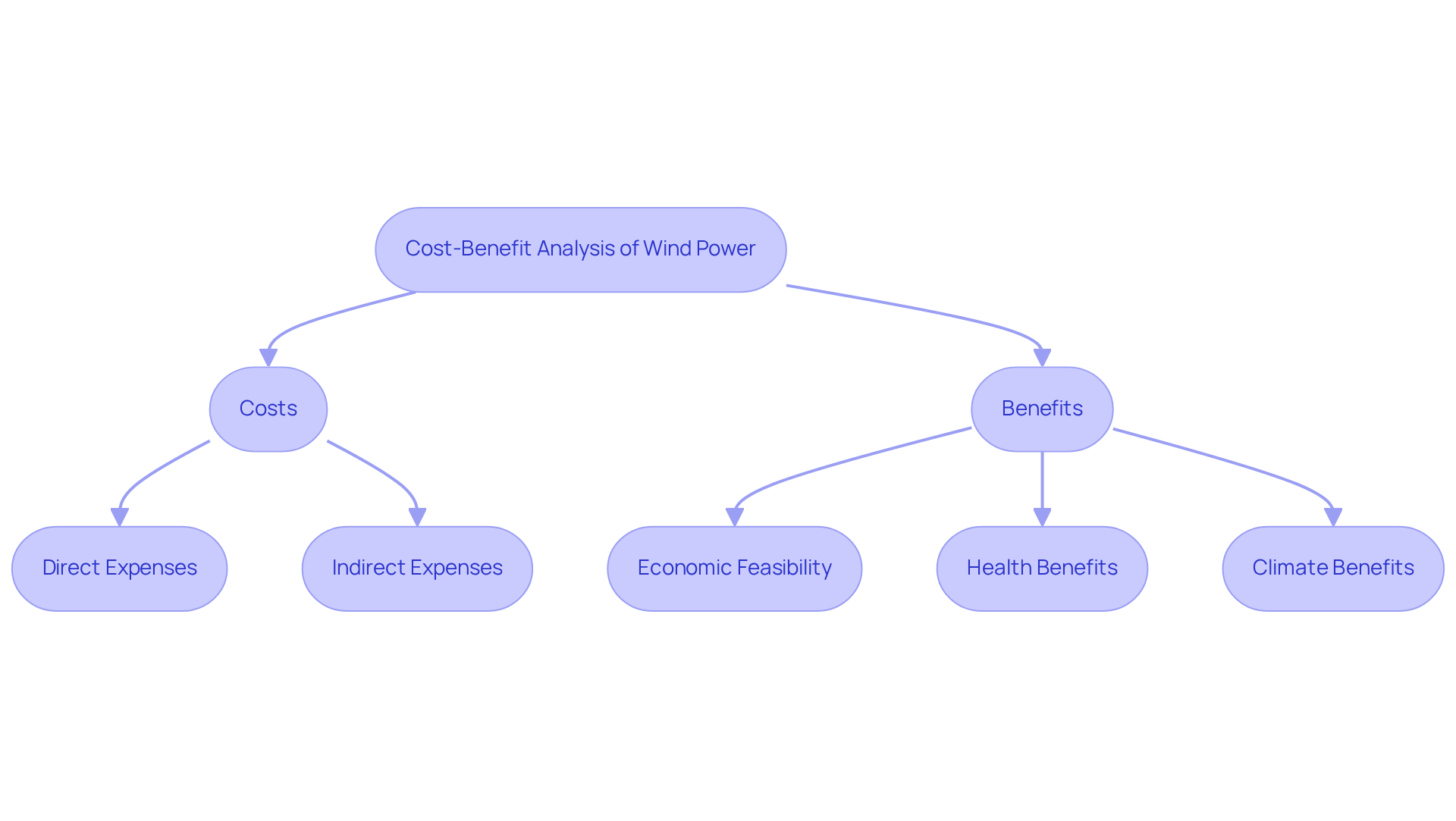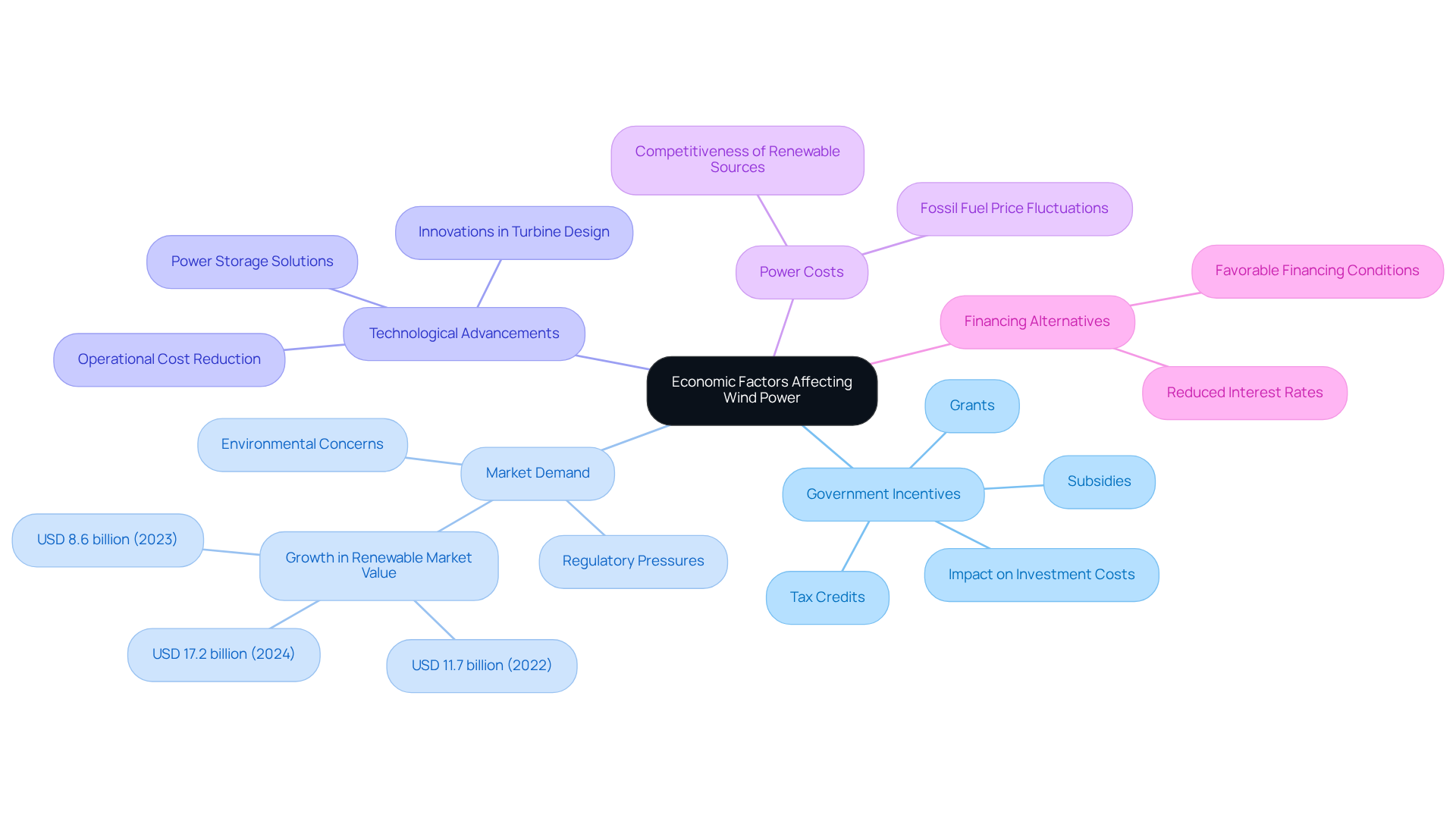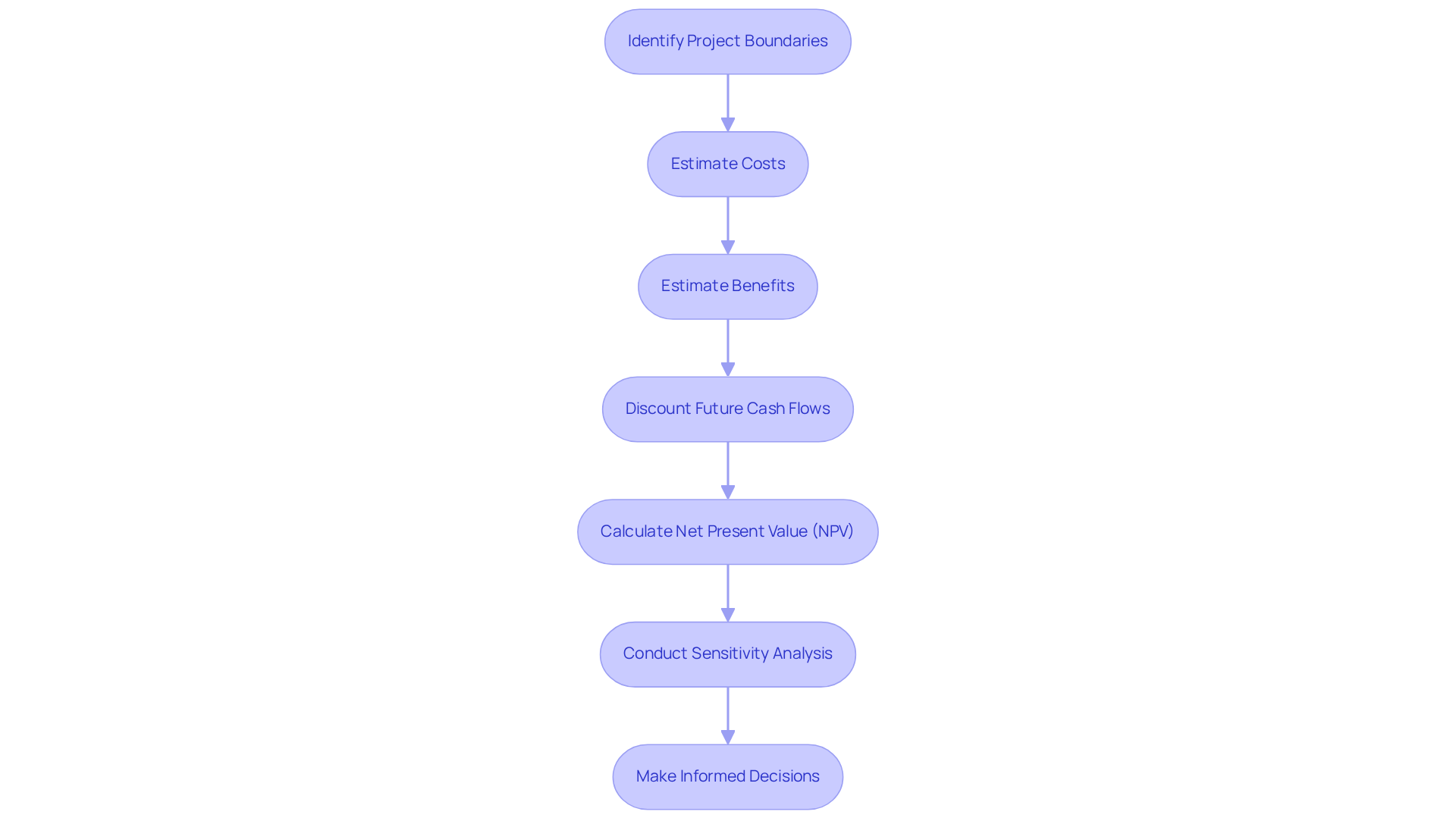Overview
This article serves as a comprehensive step-by-step guide for conducting a cost-benefit analysis (CBA) of wind power projects. It underscores the critical importance of comparing costs against expected benefits to ascertain economic feasibility. Key components are meticulously outlined, including:
- Estimation of costs and benefits
- Discounting future cash flows
- Calculating net present value
Furthermore, it highlights the significance of government incentives and technological advancements, which play a pivotal role in enhancing the attractiveness of wind energy investments.
Introduction
The transition to renewable energy sources is not merely a trend; it signifies a fundamental shift in society's approach to power generation. Among these sources, wind power distinguishes itself with the potential to deliver sustainable energy alongside substantial economic benefits. However, a pressing question persists: how can stakeholders accurately assess the viability of wind projects? This article explores the intricacies of conducting a cost-benefit analysis for wind power, unveiling essential steps and economic factors that can guide informed decision-making and maximize returns in this evolving landscape.
Define Cost-Benefit Analysis in Wind Power
The cost-benefit analysis of wind power serves as a structured framework for evaluating the economic feasibility of renewable energy initiatives by comparing expected expenses against projected advantages. This analysis encompasses both direct expenses, such as installation and maintenance, and indirect expenses, which include environmental impacts and social implications.
Recent research indicates that the average installed cost of turbine energy initiatives in 2020 was $1,460 per kilowatt (kW), reflecting a decrease of more than 40% since 2010. Additionally, the average levelized cost of newly constructed turbine energy facilities stands at just over $30 per megawatt-hour (MWh). In 2020, wind power contributed over 8% to the nation’s electricity supply.
By quantifying these elements, stakeholders are empowered to perform a cost-benefit analysis of wind power, enabling them to make informed decisions regarding project feasibility and ensuring that benefits consistently outweigh costs throughout the project's lifespan. Furthermore, the cost-benefit analysis of wind power assists in identifying potential risks and uncertainties, facilitating enhanced strategic planning and resource allocation within the power sector.
The growing recognition of the economic feasibility of renewable resources is driven by technological advancements and supportive government policies, positioning it as an attractive option for sustainable power development. Moreover, considering the health and climate benefits of renewable energy, which averaged $76 per MWh in 2020, further solidifies the economic rationale for these initiatives.

Examine Economic Factors Affecting Wind Power
Numerous economic elements significantly impact the success of renewable energy initiatives. Understanding these factors is essential for stakeholders navigating the complexities of power investments and conducting a cost-benefit analysis of wind power to optimize returns.
-
Government Incentives: Subsidies, tax credits, and grants play a crucial role in reducing initial investment costs for wind projects, enhancing their appeal to investors. In 2023, global cumulative installed renewable energy capacity reached 1,136 gigawatts, underscoring the effectiveness of these incentives in driving market growth.
-
Market Demand: The demand for renewable power sources is on the rise, fueled by environmental concerns and regulatory pressures. This trend can enhance the profitability of wind-based solutions. As Ankit Gupta notes, the U.S. renewable market was valued at USD 11.7 billion, USD 8.6 billion, and USD 17.2 billion in 2022, 2023, and 2024 respectively, indicating significant market potential.
-
Technological Advancements: Innovations in turbine design and power storage solutions lower operational costs and improve efficiency, which are essential for conducting a cost-benefit analysis of wind power. Case studies reveal how advancements in turbine technology contribute to profitability through enhanced ROI.
-
Power Costs: Fluctuations in fossil fuel prices can affect the competitiveness of renewable sources. Lower fossil fuel prices may diminish the urgency for sustainable investments, making it vital for stakeholders to understand these dynamics.
-
Financing Alternatives: Access to favorable financing conditions can enhance the viability of renewable energy initiatives. Reduced interest rates can lower the total cost of capital, which is particularly relevant in light of the anticipated expansion in the U.S. energy sector.
In summary, comprehending these economic elements is essential for stakeholders aiming to navigate the intricacies of power investments and maximize their returns.

Conduct a Step-by-Step Cost-Benefit Analysis for Wind Projects
To effectively conduct a Cost-Benefit Analysis (CBA) for wind projects, it is essential to follow these structured steps:
-
Identify Project Boundaries: Clearly define the parameters of the wind initiative, encompassing location, size, and the technology to be utilized.
-
Estimate Costs: Calculate all associated costs, which include:
- Initial capital costs (turbines, installation, infrastructure)
- Operational and maintenance costs
- Decommissioning costs at the end of the project life.
-
Estimate Benefits: Quantify the expected benefits, such as:
- Revenue from energy sales
- Environmental benefits (reduced emissions)
- Social benefits (job creation, energy independence).
-
Discount Future Cash Flows: Apply a discount rate to future cash flows to account for the time value of money, ensuring that benefits and expenses are comparable over time.
-
Calculate Net Present Value (NPV): Subtract total expenses from total benefits to determine the NPV, which indicates the profitability of the endeavor.
-
Conduct Sensitivity Analysis: Assess how changes in key assumptions (e.g., energy prices, operational costs) affect the CBA results, providing insights into potential risks.
-
Make Informed Decisions: Utilize the CBA results to guide investment decisions, project modifications, or stakeholder negotiations, ensuring that the chosen path aligns with strategic goals.

Conclusion
The cost-benefit analysis of wind power serves as a crucial instrument for evaluating the economic viability of renewable energy projects, enabling stakeholders to balance expected costs against projected benefits. This structured approach empowers decision-makers to ensure that investments in wind energy align not only with financial objectives but also with positive environmental and social outcomes.
Key insights from the analysis underscore the significance of comprehending economic factors such as:
- Government incentives
- Market demand
- Technological advancements
- Financing options
These elements are instrumental in shaping the landscape of wind power investments and can greatly influence the overall success of renewable energy initiatives. Adopting a systematic step-by-step guide for conducting a cost-benefit analysis equips stakeholders to navigate complexities and make informed decisions that enhance project feasibility.
Ultimately, embracing the cost-benefit analysis framework for wind power is essential for propelling sustainable energy development. By acknowledging the economic potential of wind energy and leveraging supportive policies, stakeholders can effectively contribute to a cleaner, more resilient energy future. Engaging in this analysis not only aids in individual project decisions but also fosters broader advancements in renewable energy adoption, illustrating the critical role of informed investment strategies in combating climate change.
Frequently Asked Questions
What is cost-benefit analysis in the context of wind power?
Cost-benefit analysis in wind power is a structured framework for evaluating the economic feasibility of renewable energy initiatives by comparing expected expenses against projected advantages, including both direct and indirect costs.
What types of expenses are considered in the cost-benefit analysis of wind power?
The analysis includes direct expenses such as installation and maintenance costs, as well as indirect expenses, which encompass environmental impacts and social implications.
What was the average installed cost of turbine energy initiatives in 2020?
The average installed cost of turbine energy initiatives in 2020 was $1,460 per kilowatt (kW), representing a decrease of more than 40% since 2010.
What is the average levelized cost of newly constructed turbine energy facilities?
The average levelized cost of newly constructed turbine energy facilities in 2020 was just over $30 per megawatt-hour (MWh).
How much did wind power contribute to the nation's electricity supply in 2020?
In 2020, wind power contributed over 8% to the nation’s electricity supply.
How does cost-benefit analysis help stakeholders in the wind power sector?
By quantifying expenses and benefits, stakeholders can perform a cost-benefit analysis to make informed decisions regarding project feasibility and ensure that benefits outweigh costs throughout the project's lifespan.
What additional advantages does cost-benefit analysis provide in wind power projects?
Cost-benefit analysis assists in identifying potential risks and uncertainties, facilitating better strategic planning and resource allocation within the power sector.
What factors are driving the recognition of the economic feasibility of renewable resources?
The growing recognition is driven by technological advancements and supportive government policies, making renewable resources an attractive option for sustainable power development.
What were the health and climate benefits of renewable energy in 2020?
The health and climate benefits of renewable energy averaged $76 per megawatt-hour (MWh) in 2020, reinforcing the economic rationale for these initiatives.
List of Sources
- Define Cost-Benefit Analysis in Wind Power
- Ecological and economic cost-benefit analysis of offshore wind energy | Request PDF (https://researchgate.net/publication/222657682_Ecological_and_economic_cost-benefit_analysis_of_offshore_wind_energy)
- What is Cost-Benefit Analysis? Definition, Examples | Appinio Blog (https://appinio.com/en/blog/market-research/cost-benefit-analysis)
- Economic Analyses of Wind Energy Projects - energypedia (https://energypedia.info/wiki/Economic_Analyses_of_Wind_Energy_Projects)
- Wind Energy Benefits Outweigh Costs | Energy Technologies Area (https://eta.lbl.gov/news/wind-energy-benefits-outweigh-costs)
- Economic Viability of Wind Energy: A Cost-Benefit analysis of Wind Energy (https://ijaresm.com/economic-viability-of-wind-energy-a-cost-benefit-analysis-of-wind-energy-installations)
- Examine Economic Factors Affecting Wind Power
- 10 Essential Wind Energy ROI Studies for Informed Development (https://blog.harbingerland.com/10-essential-wind-energy-roi-studies-for-informed-development)
- The Executive Headlines - Top business magazine & news headlines sources (https://executiveheadlines.com/erp/quotes-on-sustainable-energy)
- Wind Energy - Worldwide | Statista Market Forecast (https://statista.com/outlook/io/energy/renewable-energy/wind-energy/worldwide)
- Wind Energy Market Size, Growth Outlook 2025-2034 (https://gminsights.com/industry-analysis/wind-energy-market)
- Wind Fail: 20 Quotes for 30 Years of False Hopes - American Energy Alliance (https://americanenergyalliance.org/2015/07/wind-fail-20-quotes-for-30-years-of-false-hopes)
- Conduct a Step-by-Step Cost-Benefit Analysis for Wind Projects
- WINDExchange: Economics and Incentives for Wind (https://windexchange.energy.gov/projects/economics)
- A Net-Present Value Analysis for a Wind Turbine Purchase at a Small US College (https://mdpi.com/1996-1073/3/5/943)
- Wind Turbine Cost: Worth The Million-Dollar Price In 2022? (https://weatherguardwind.com/how-much-does-wind-turbine-cost-worth-it)
- Wind Energy Statistics By Industry Jobs, Operating Capacity, Technology And Facts (2025) (https://sci-tech-today.com/stats/wind-energy-statistics-updated)
- Cost-Benefit Analysis: Step-by-Step Guide & Examples | Rippling (https://rippling.com/blog/cost-benefit-analysis-example)




